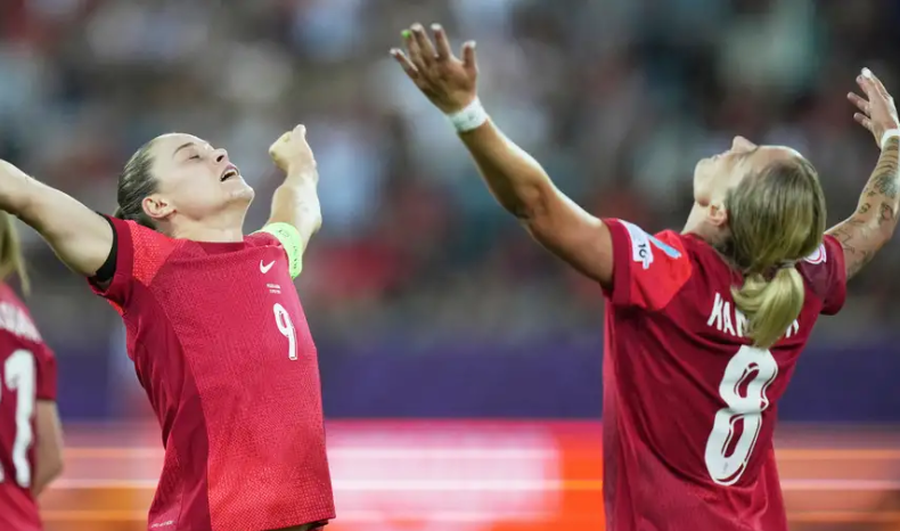
The European Women's Football Championship is attracting more and more viewers. But only one team from Eastern Europe qualified for Euro 2025. Why doesn't women's football find the same resonance as men's football?
"This is more than a tournament. It is a movement, and a response from all over Europe and beyond, that proves that women's football will set new standards." These were the words of Nadine Kessler, a former internationally renowned German player who was this time UEFA's director of women's football during "Euro 2025". Her statement cannot be disputed: UEFA said that it sold more tickets - even before the start of the group stage - than during the entire "Euro 2022". Posts on social networks reached 55% and the value of the prize money for the winners has increased by 156%, reaching the figure of 41 million euros.
But while Poland managed to qualify, the movement has not included other Eastern European nations. Despite winning their final group game against Denmark, Poland exited the group stage, as did Ukraine in 2009 and Russia five times between 1997 and 2022, when it was banned from international football.
This is in stark contrast to men's football, where 11 of the 24 teams that qualified for the last men's European Championship, which was held in Germany in 2024, were from Eastern Europe, despite their lack of success. Croatia was one of the teams that reached the final of the 2018 World Cup and four years later reached the semi-finals in Qatar. Croatia's women's team, on the other hand, has never come close to qualifying for a European or World Cup.
Goran Ljubojevic, former coach and now sports director of the multiple-time champion women's team, "ZNK Osijek," told DW that the region started women's football later than others, around the 1990s, and investment has been minimal. But he believes that social norms have also hindered women's football.
"Men's game"
"The cultural problem in our countries is that people think that girls shouldn't play football, that they should stay at home and be housewives and stuff like that," he told DW. The European Union's Gender Equality Index, published in 2024, confirms this to some extent, as eastern countries are below the European average. "I don't know if we will ever see a change in the male mentality in Croatia, and if we will ever accept that women's football is on the same level as men's football, like it is in Western Europe and the United States."
Ljubojevic, who has played for NK Osijek and Dinamo Zagreb, says that the packed stadiums and growing interest in European tournaments are starting to have an impact on his country. "People who watched the matches at the European Championship saw the stadiums full of tears at the World Cup in Australia and New Zealand in 2023. They were left speechless and amazed by the great interest in women's football. And something changed in their minds. But still, the infrastructure is not there yet, so that women's football can improve."
Despite being the most successful in their country, "ZNK Osijek" are followed by very few people in the stadium. According to Ljubojevic, the talent exists but there is a lack of investment in coaches, infrastructure and there is insufficient payment for the players, so that they can be full-time professionals.
Growing budgets
UEFA has been implementing new schemes in the region in recent years and they are starting to have an impact, according to Professor Dariusz Wojtaszyn of the University of Wroclaw in Poland. "There have been many positive developments in recent years. They have been driven by initiatives from UEFA and local football associations, initiatives which, although slowly, have started to recognise the potential of girls' football," academic Wojtaszyn, who has written extensively about girls' football in Eastern Europe, told DW.
"Budgets in women's football have increased significantly (usually more than 100%) in all countries of Eastern and Central Europe. For this reason, I see UEFA's initiatives with great positivity. They really bring tangible results."
In a written response, UEFA told Deutsche Welle that the redesigned competitions, including the Champions League and Europa League, "have enabled all competitions and finals to remain open and accessible to clubs and teams from all associations. During this period, we have seen impressive performances from Eastern European clubs at club and national level, including youth teams. We will continue to work with the relevant associations, with the aim of improving performance and developing football on a pan-European level."
History and politics
But Wojtaszyn believes that regional politics have been a hindrance. Although the communist systems that governed many of these countries until the 1990s declared themselves to respect gender equality, they in fact produced "a patriarchal model of the family and traditional social relations, which limited the possibilities of women's emancipation," the academic argues. The fall of communism then rooted even greater problems. "The collapse of the state sponsorship system that had existed in previous decades caused significant economic problems for football clubs. In such conditions, women's football, which was attracting less and less interest, had an extremely difficult time finding sponsors in the free market, where male competition was great. Therefore, teams began to suffer financially, gatherings became increasingly difficult, and female players began to play amateur sports," he says.
In more recent times, he adds, the rise of far-right parties in countries like Romania, Poland, Slovakia and Hungary – and the revival of “traditional” values that followed this rise – have made professional football an unattractive proposition for many women. Although his players have to do other jobs to make ends meet, Ljubojevic has high hopes for the future, although he is convinced that a lot of investment and education is needed.
Inspiring examples
"We have a huge amount of talent, just like we have in men's football, but no one has trained them properly," he says. "It will be much better in the coming years. I'm telling you, we have fantastic talent, fantastic players and we (ZNK Osijek) are already working at very high levels."
Poland is expecting a surge in participation from its campaigns in the run-up to the European Championship. Coach Nina Patalon predicts an increase from 30,000 to 300,000 female players in her country.
Ljubojevic thinks Croatia and perhaps other countries in the region need something similar to increase the number of girls in football. Although Poland failed to advance to this year's tournament, and no Eastern European country has applied for 2029, he would like to see Croatia become the first country in the region to host a women's football tournament. "Yes, we can do it. But we have to take it seriously. The federation, the state, everyone. We have to invest time and money. Women's football is the new wave that is coming and we have to swim. But we are not swimming yet."/ DW (A2 Televizion)











